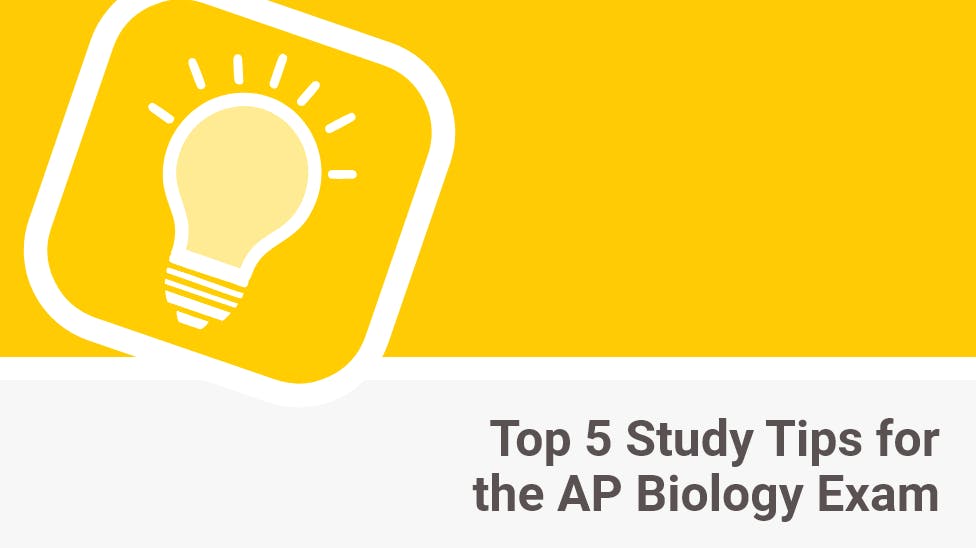Top 5 Study Tips for the AP Biology Exam
April 8, 2024

Studying for the AP Biology exam can feel overwhelming if you don’t know where to start. Developing a strong knowledge of the following five content areas and the tips below will help you get on the path to a 5 on the AP Biology exam.
AP Biology Study Tip #1: Everything connects to the four Big Ideas.
The AP Biology course and exam are structured around four Big Ideas:
- Evolution
- Energetics
- Information Storage and Transmission
- Systems Interactions
As you review the eight units of AP Biology, notice how the Big Ideas are interwoven throughout multiple units. For example, Big Idea 3 (Information Storage and Transmission) is covered in five units. This idea is first introduced in Unit 1 during the discussion of nucleic acids. This idea reappears in many topics of Unit 4 (such as cell communication, signal transduction, and the cell cycle) and in several topics of Unit 5 (including Mendelian genetics and non-Mendelian genetics). Big Idea 3 is also included in every topic of Unit 6 (gene expression and regulation). Finally, this concept is covered in Unit 8, when discussing ecological responses to the environment. As seen from this example, the Big Ideas are the foundation of this course and exam, and it is important to recognize how each of these four concepts connects with multiple units and topics.
AP Biology Study Tip #2: Learn how to explain concepts and analyze visual representations.
(Science Practices 1 and 2)
You must be able to:
- Describe and explain biological concepts in applied situations
- Construct a visual model (a diagram or a graph) of the characteristics of a biological system
- Given a visual representation of a biological system, describe the interactions and relationships between the components of the system
AP Biology Study Tip #3: Know how to ask testable questions and design experiments and methods to test those questions.
(Science Practice 3)
You must be able to:
- State the null hypothesis and design an experiment to test it
- State the alternative hypothesis and design an experiment to test it
- Identify the components of an experiment, including appropriate controls, the independent and dependent variables, and experimental constants
- Use experimental data to evaluate a hypothesis
- Design a follow-up experiment
AP Biology Study Tip #4: Show that you can represent data in an appropriate graph and that you can accurately describe that data.
(Science Practice 4)
You must be familiar with the uses of the following types of graphs:
- Line graph
- Bar graph
- Histogram
- Pie chart
- Scatterplot
- Box and whisker plot
- Graphs with two y-axes (dual y)
AP Biology Study Tip #5: Demonstrate that you can use statistical tests to analyze data and that you know how to use the results of these statistical tests to support or reject claims and hypotheses.
(Science Practices 5 and 6)
You should be familiar with the following calculations and statistical tests:
- Means
- Rate calculations
- Ratios and percentages
- 95% confidence intervals (error bars)
- Chi-square
AP Biology Resources
- About the AP Biology Exam
- Top AP Biology Exam Strategies
- Top 5 Study Topics and Tips for the AP Biology Exam
- AP Biology Short Free-Response Questions
- AP Biology Long Free-Response Questions
AP Psychology Resources
- What’s Tested on the AP Psychology Exam?
- Top 5 Study Tips for the AP Psychology Exam
- AP Psychology Key Terms
- Top AP Psychology Exam Multiple-Choice Question Tips
- Top AP Psychology Exam Free Response Questions Tips
- AP Psychology Sample Free Response Question
AP English Language and Composition Resources
- What’s Tested on the AP English Language and Composition Exam?
- Top 5 Tips for the AP English Language and Composition Exam
- Top Reading Techniques for the AP English Language and Composition Exam
- How to Answer the AP English Language and Composition Essay Questions
- AP English Language and Composition Exam Sample Essay Questions
- AP English Language and Composition Exam Multiple-Choice Questions
